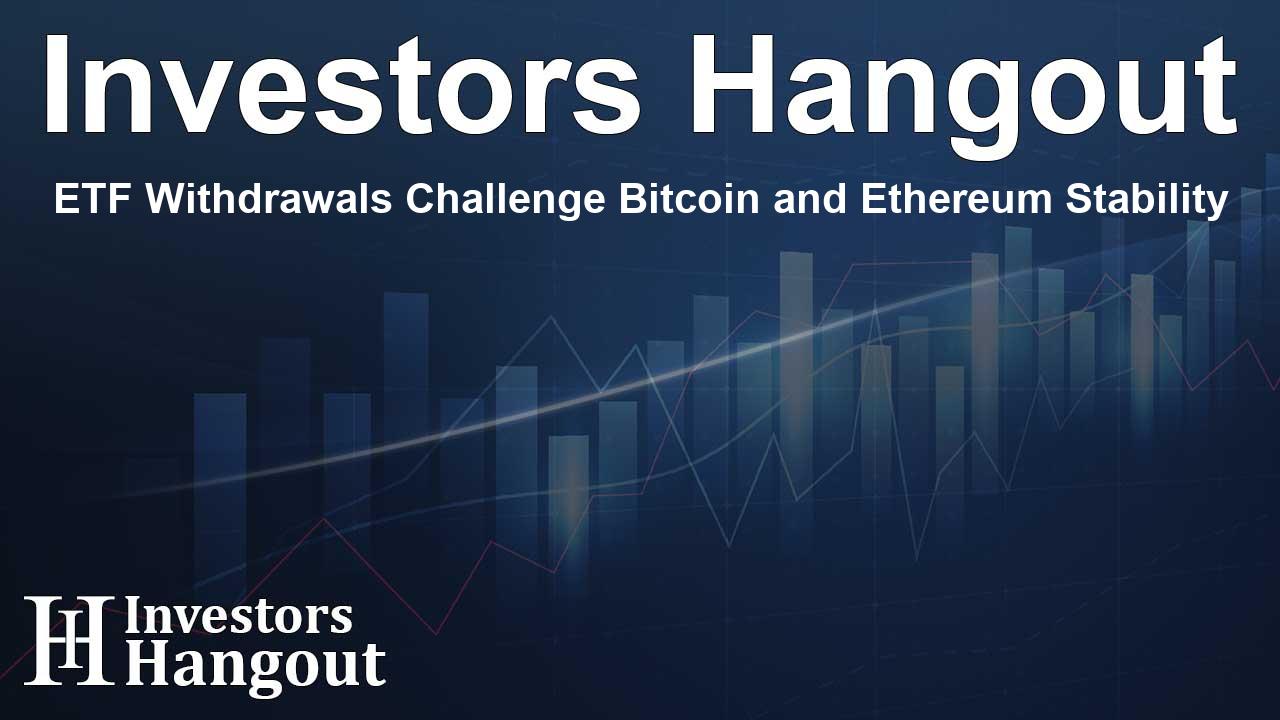ETF Withdrawals Challenge Bitcoin and Ethereum Stability

Bitcoin and Ethereum ETFs Experience Major Outflows
The recent performance of Bitcoin (CRYPTO: BTC) and Ethereum (CRYPTO: ETH) ETFs has captured significant attention as they collectively experienced outflows totaling $755 million. Despite this concerning trend, technical analysis offers a glimmer of hope, indicating that the cryptocurrencies might not be as weak as the outflows suggest.
Bitcoin ETF Withdrawals: BlackRock Stands Out
Data compiled indicates that U.S. Bitcoin ETFs suffered about $326 million in outflows on a specific recent date. Grayscale's Bitcoin Trust recorded redemptions of $145 million, while Fidelity’s fund and Ark’s ETF faced losses of $93 million and $211 million, respectively.
However, BlackRock's iShares Bitcoin Trust (NASDAQ: IBIT) defied this downward trend, gaining $60 million in inflows and boasting net assets of approximately $93 billion. Remarkably, cumulative inflows for all U.S. Bitcoin ETFs still exceed $62.4 billion, demonstrating persistent long-term institutional interest despite short-term volatility.
Ethereum ETF Struggles Amidst Institutional Uncertainty
In parallel, Ethereum ETFs faced significant selling pressure, incurring outflows of $428 million. Leading the charge in these withdrawals was BlackRock's iShares Ethereum Trust (NASDAQ: ETHA) with a staggering $310 million in redemptions, followed by Grayscale's Ethereum Trust (NYSE: ETHE) with $21 million.
As a result, the total assets under ETFs now hover near $28.7 billion, accounting for about 5.56% of Ethereum’s total market cap. This disparity underscores Bitcoin’s stronger institutional backing relative to Ethereum’s comparatively fragile investor base.
Current Bitcoin Price Trends and Technical Support
Evaluating Bitcoin’s market performance, it recently dipped to around $111,500 after struggling to retake resistance levels near $116,000, where both the 20-day and 50-day exponential moving averages converge. Nevertheless, this decline respected its upward trend established in April, with the $111,000 level acting as a critical short-term support and the 200-day EMA around $108,000 providing a secondary safety net.
As long as Bitcoin maintains its position above $108,000, the bullish projection towards $128,000 remains intact. Resistance has been identified at around $124,500, aligning with the upper barrier of the ascending channel.
Ethereum’s Price Resilience Amid Inflows
Ethereum has also demonstrated resilience, defending the $3,900 mark despite the large-scale outflows. After failing to maintain momentum above the $4,600 to $4,800 resistance range, Ethereum fell to approximately $3,975. This price correction coincided with extensive ETF withdrawals, fostering an environment ripe for short-term weaknesses.
Despite this pressure, Ethereum is also managing to maintain its upward trend, with the critical support marked by the 200-day EMA situated around $3,540. Current momentum indicators are revealing signs of stabilization rather than outright breakdowns, noted by a stabilizing RSI and a flattening MACD.
If Ethereum can uphold its position above the $3,900 to $3,600 range, the potential for a rebound towards $4,250 to $4,600 gains traction. However, a dip below the $3,540 mark could invalidate this bullish outlook, opening the doors for drops toward $3,200.
Contrasts in ETF Flows and Chart Patterns for BTC and ETH
Even amidst considerable ETF outflows, both Bitcoin and Ethereum remain within longer-term bullish formations. This dissonance between institutional movements and technical facets suggests that the outflows might represent a momentary repositioning rather than a fundamental loss of faith in the market.
For Bitcoin, the maintenance of the $108,000 to $111,000 range keeps the open possibility for advancement towards $128,000. Similarly, securing levels above $3,600 remains vital for Ethereum’s potential near-term resurgence.
The interaction of declining ETF flows with sustained trendlines highlights the possibility of a sentiment-driven flush rather than a complete industry shift. Continuing to examine these markets closely will provide insight into future movements and investor confidence.
Frequently Asked Questions
What are Bitcoin and Ethereum ETFs?
Bitcoin and Ethereum ETFs allow investors to gain exposure to these cryptocurrencies without directly owning them, tracking their price movements.
Why did Bitcoin and Ethereum ETFs experience significant outflows?
The recent outflows are attributable to market volatility and investor repositioning, leading to a reassessment of risks in the crypto market.
What technical indicators suggest future performance for Bitcoin?
Key indicators include the trending support lines at $111,000 and $108,000, with potential bullish movement if these levels hold.
How do institutional investments impact Bitcoin and Ethereum?
Institutional investments often provide stability and legitimacy to cryptocurrency markets, influencing pricing dynamics and market sentiment.
What should investors watch for in Bitcoin and Ethereum moving forward?
Monitoring key support levels, resistance points, and ETF inflow or outflow trends will be essential for forecasting future price movements.
About The Author
Contact Ryan Hughes privately here. Or send an email with ATTN: Ryan Hughes as the subject to contact@investorshangout.com.
About Investors Hangout
Investors Hangout is a leading online stock forum for financial discussion and learning, offering a wide range of free tools and resources. It draws in traders of all levels, who exchange market knowledge, investigate trading tactics, and keep an eye on industry developments in real time. Featuring financial articles, stock message boards, quotes, charts, company profiles, and live news updates. Through cooperative learning and a wealth of informational resources, it helps users from novices creating their first portfolios to experts honing their techniques. Join Investors Hangout today: https://investorshangout.com/
The content of this article is based on factual, publicly available information and does not represent legal, financial, or investment advice. Investors Hangout does not offer financial advice, and the author is not a licensed financial advisor. Consult a qualified advisor before making any financial or investment decisions based on this article. This article should not be considered advice to purchase, sell, or hold any securities or other investments. If any of the material provided here is inaccurate, please contact us for corrections.
